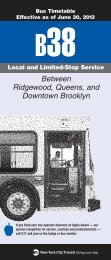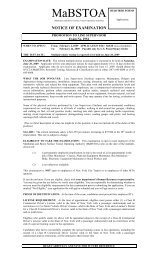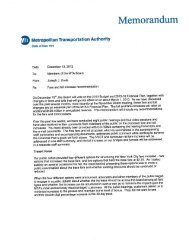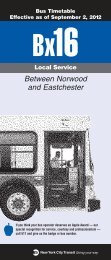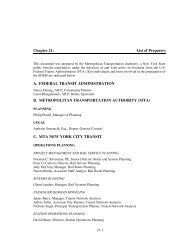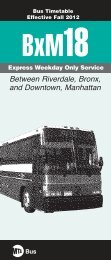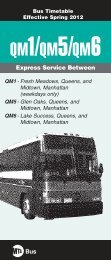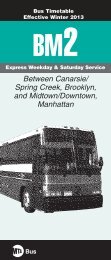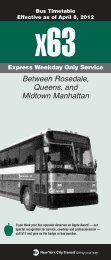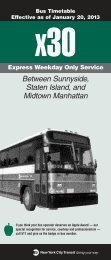Greening Mass Transit & Metro Regions: The Final Report - MTA
Greening Mass Transit & Metro Regions: The Final Report - MTA
Greening Mass Transit & Metro Regions: The Final Report - MTA
You also want an ePaper? Increase the reach of your titles
YUMPU automatically turns print PDFs into web optimized ePapers that Google loves.
22<br />
Recommendation 1. Accelerate NYPA Energy Retrofits and Energy-Efficiency Projects<br />
<strong>The</strong> <strong>MTA</strong> should expand its energy retrofits in collaboration with NYPA, which now have a proven record of significant<br />
and compounding energy savings. At present, the <strong>MTA</strong> plans to nearly double its program of energy retrofits and energyefficiency<br />
projects with NYPA. To set a clear framework for this important source of energy savings, the Commission<br />
recommends that the <strong>MTA</strong> set a goal of re-evaluating the energy efficiency potential in 100 percent of major <strong>MTA</strong><br />
facilities every 10 years.<br />
A Greener Subway Track<br />
Some energy savers, like Compact Fluorescent Lightbulbs (CFLs) in subway tunnels, are no-brainers. Others are not so obvious, such as the engineering of “humped tracks” on the<br />
Second Avenue Subway project. By adjusting track inclines at stations, designers use gravity to reduce the energy trains expend in braking and acceleration, shaving extra kilowatts<br />
off each train arrival. Similarly, minute calibrations of the turn radius in tracks can minimize energy loss in braking. <strong>MTA</strong>’s R160 subway cars, equipped with regenerative braking,<br />
have the potential to capture the braking energy as trains enter a station and transfer it to trains departing on the adjacent tracks. With the conversion to an all AC fleet, the <strong>MTA</strong><br />
would have the opportunity to use the full potential of regenerative braking and capture significant energy savings.<br />
2nd Ave Subway Cross Section – Humped Tracks<br />
NEAR-TERM RECOMMENDATIONS<br />
Recommendation 2. Field Test and Implement Weight Reduction and Regenerative-Braking<br />
Technologies, as Recommended by the Commission’s Smart Fleets Task Force<br />
<strong>The</strong> <strong>MTA</strong> should reduce its demand for propulsion power and fuel by moving aggressively to identify and implement the<br />
most energy-efficient innovations being tested in its Smart Fleets program. Both regenerative-braking systems and design<br />
innovations that lighten the weight of rolling stock while maintaining safety are the most promising advances in the current<br />
Smart Fleet programs. <strong>The</strong> <strong>MTA</strong> must continue to expedite testing of new technologies that shave the energy expended for<br />
traction power, by far the <strong>MTA</strong>’s largest energy demand.<br />
Recommendation 3. Expand the Use of LED Lighting<br />
<strong>The</strong> <strong>MTA</strong> should expand its use of LED lighting within the <strong>MTA</strong> system by taking advantage of opportunities for LED fixtures<br />
in signals, emergency cut-off lights, tunnel lighting, and other applications. <strong>The</strong> <strong>MTA</strong> should also expedite its replacement<br />
of bridge necklace lighting with new LED fixtures, which testing indicates cut energy consumption by approximately 73 percent<br />
and reduce crew maintenance costs. For the pilot project at the Verrazano-Narrows Bridge, LED necklace lights were delivered<br />
in November 2008 and installation will be completed by June 2009. <strong>The</strong> <strong>MTA</strong> should undertake LED installations at the<br />
three major remaining <strong>MTA</strong> bridges (Bronx-Whitestone, Robert F. Kennedy, and Throgs Neck).<br />
LED Bridge Lightning<br />
<strong>The</strong> <strong>MTA</strong> has begun replacing the existing necklace<br />
lighting on the Verrazano-Narrows Bridge with LED<br />
lighting, significantly reducing energy consumption,<br />
maintenance costs, and waste.



